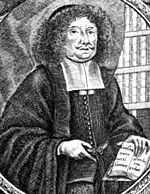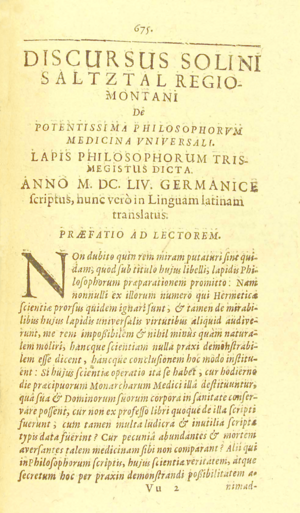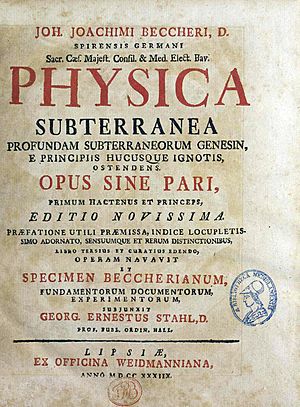Johann Joachim Becher facts for kids
Quick facts for kids
Johann Becher
|
|
|---|---|
 |
|
| Born | 6 May 1635 |
| Died | October 1682 (aged 47) |
| Known for | Phlogiston theory |
| Scientific career | |
| Fields | Chemistry, alchemy |
| Influenced | Georg Ernst Stahl |
Johann Joachim Becher (born May 6, 1635 – died October 1682) was a smart German doctor, alchemist, and early chemist. He was also a scholar and an adventurer. He is most famous for developing the phlogiston theory, which was an early idea about how things burn. He also helped advance an economic idea called Austrian cameralism.
Contents
A Young Scholar's Start
Becher was born in Speyer during a big war called the Thirty Years' War. His father was a Lutheran minister who died when Johann was very young. By the age of thirteen, Johann had to take care of himself, his mother, and his two brothers.
He learned many different skills and worked hard to support his family. He spent his nights studying all sorts of subjects. He even earned a little money by teaching others.
In 1654, when he was just nineteen, he published a book. It was about a powerful "universal medicine" that philosophers called the "Philosopher's Stone." He used a fake name, 'Solinus Salzthal of Regiomontus,' for this book.
Becher's Busy Career
In 1657, Becher became a professor of medicine at the University of Mainz. He also became a doctor to the important archbishop-elector there.
He published many books during his career:
- In 1660, he released Metallurgia, about metals.
- The next year, he published Character pro notitia linguarum universali. In this book, he listed 10,000 words for a universal language that everyone could use.
- In 1663, he wrote Oedipum Chemicum and another book about animals, plants, and minerals.
Working for the Emperor
In 1666, Becher moved to Vienna. He became a business advisor (called a Commerzienrat) to Emperor Leopold I. The Emperor sent him on a trip to the Netherlands. While there, Becher quickly wrote two more books about teaching methods and rules for alliances.
In 1669, he published his important work, Physica subterranea. In the same year, he worked with the Count of Hanau on a plan to get land in Dutch colonization of Guiana from a Dutch trading company.
Later, he became a doctor to the elector of Bavaria. But in 1670, he was back in Vienna. He gave advice on setting up a silk factory. He also suggested big plans for a trading company with the Low Countries and a canal to connect the Rhine and Danube rivers.
Travels and Final Years
In 1678, Becher traveled to England. He visited mines in Scotland and Cornwall at the request of Prince Rupert. He spent a year exploring the mines there.
In 1680, he presented a paper to the Royal Society. In it, he tried to say that another scientist, Christiaan Huygens, didn't deserve credit for using the pendulum to measure time.
Becher returned to London in 1682. He wrote two more books, Närrische Weisheit und weise Narrheit and Chymischer Glücks-Hafen. He died in October of that year.
Becher's Lasting Ideas
Austrian Cameralism: Economic Ideas
Becher was a very original thinker about Austrian cameralism. This was an economic idea that focused on how a country could become strong and wealthy. After the Thirty Years' War, many towns and farms needed to recover. Becher believed that trade and business were key to helping cities grow.
He was against monopolies, where one group controls everything. He thought that many skilled workers in Austria were not part of official guilds (groups of craftsmen). He believed this was a problem for the economy.
Chemist and Alchemist: Early Science
Many people, like the famous chemist William Cullen, thought Becher was a very important chemist. They considered his book Physica Subterranea to be his most significant work. This book explored ideas about how substances change and react, which was a big step towards modern chemistry. Becher's ideas, especially his phlogiston theory, influenced later scientists like Georg Ernst Stahl.
See also
 In Spanish: Johann Joachim Becher para niños
In Spanish: Johann Joachim Becher para niños



